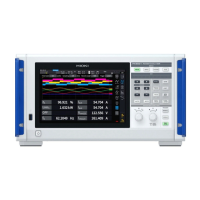34
Connecting the Current Sensors (Current Input)
2.3 Connecting the Current Sensors (Current Input)
Connect current sensors to the Probe 1 or Probe 2 terminals.
DANGER
Do not use the current sensors to measure a circuit carrying a voltage
greater than the maximum rated line-to-ground voltage.
Do not use the current sensors for measuring bare conductors.
Doing so could result in serious bodily injury or a short circuit.
*: For details about the maximum rated line-to-ground voltage of the current sensor,
refer to the instruction manual that came with the current sensor.
Connect an optional current sensor only with the Probe 1 terminal.
Using a current sensor other than the optional current sensors could cause serious
bodily injury.
WARNING
Turn o all devices before connecting a pass-through-type current
sensor of the through type, such as the CT6875.
There is a risk of the operator experiencing an electric shock. A short circuit may also
occur.
NOTICE
Do not connect or disconnect connectors while the instrument has been turned
on.
Doing so could damage the sensor.
When disconnecting cables, disengage the lock and then pull out the
connector while gripping it at the connection (do not pull on the cable).
The BNC connectors or junctions may be damaged.
Use the L9217 Connection Cord (plastic) for connection with an isolated BNC
connector (plastic).
Use the 9165 Connection Cord (metallic) for connection with a metallic BNC
connector.
If a metallic BNC cable is connected with an isolated BNC connector, the isolated
BNC connector or connected devices may be damaged.
IMPORTANT
• Connect a current sensor to either the Probe 1 or Probe 2 terminal of a single input module.
Connecting two current sensors with both the Probe 1 and Probe 2 terminals can aect
measurement.
• Do not drop a current sensor onto a oor or other surface.
• Do not subject the current sensor to mechanical shock.
Doing so could adversely aect the measurement accuracy and the opening/closing
mechanism.

